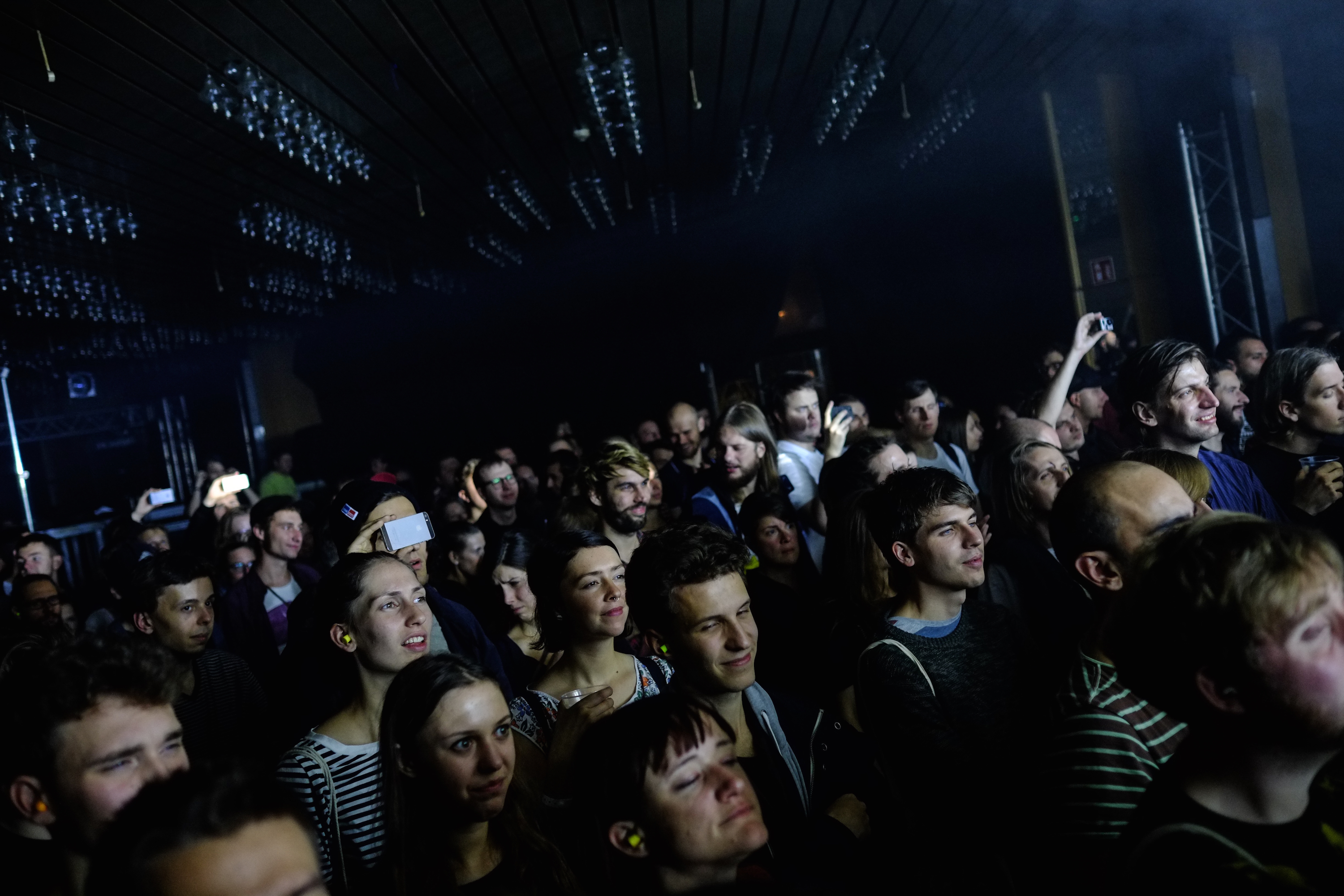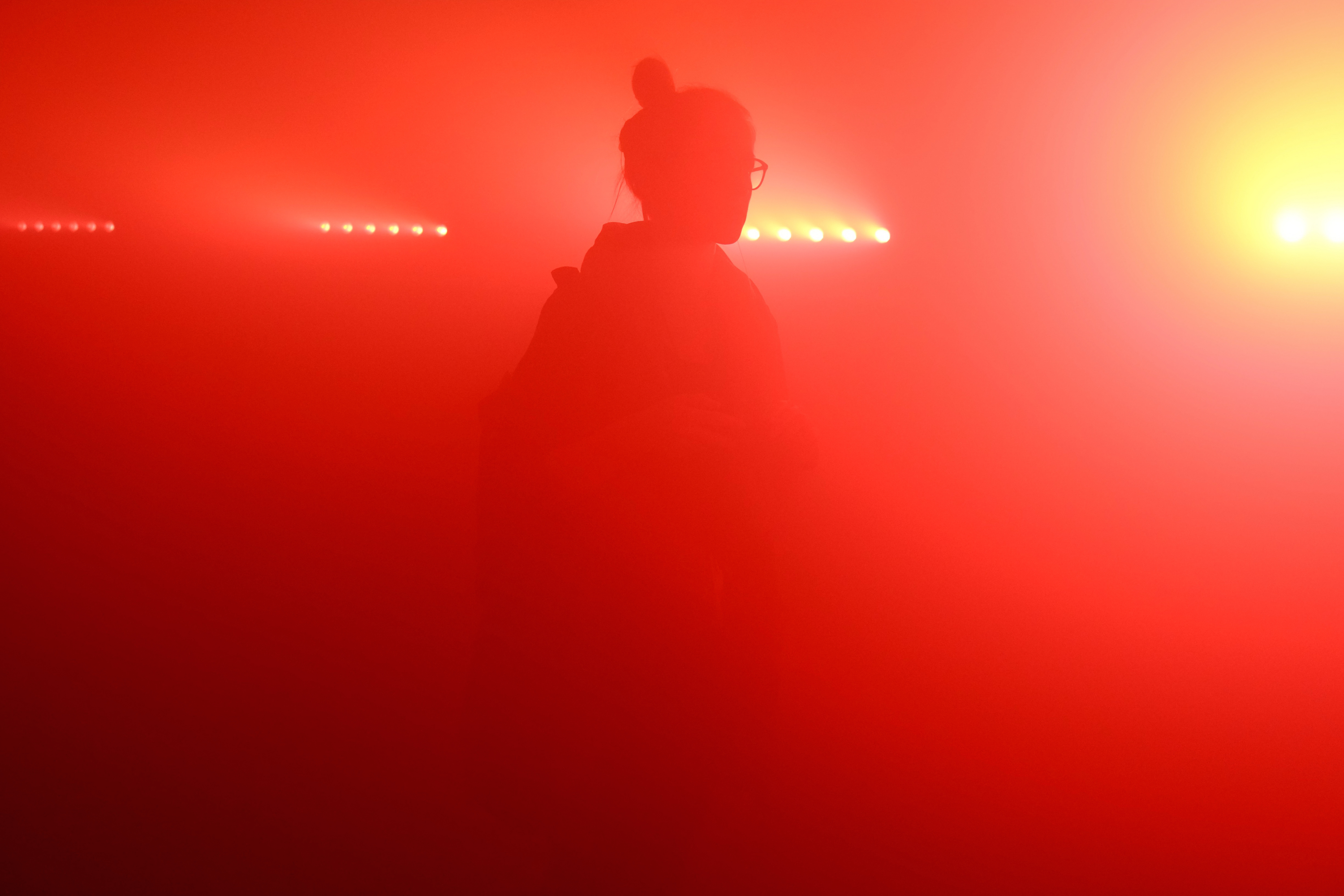

Check out a photo gallery from this year's Unsound Festival in Krakow, Poland, as well as a review of the event by Philip Sherburne.
I. A Rumor Exhumed
Was it really him? That was the question many electronic music fans were asking last weekend while standing inside of a smoke-filled chamber carved out of rock, hundreds of feet beneath the Earth. The "him" in question was Burial, and while the idea would normally be all but unthinkable—as far as I know, he's never played live or even DJed—this was the "Surprise" edition of Krakow, Poland’s annual Unsound Festival, and, with a significant chunk of the lineup kept secret until the moment the artists took the stage, all bets were off.
It certainly sounded like Burial, though it was impossible to say who the hooded figure on stage actually was. The 800-capacity hall deep in a former salt mine was already plenty smoky, but when the shadowy, unannounced act began, the lights dimmed further, the dry ice machines went into overdrive, and the atmosphere turned thick as midnight on the moors.
The set began with what sounded like the squeaking of sneakers on a basketball court; there were rustling noises and soft, backwards strings; shuffling UK garage beats and mournful melodies were threaded with the sound of running water and snippets of dialogue. There were bees, too—swarming, buzzing bees that swelled in volume between tracks. It took me three or four songs to go from thinking, "This sure sounds like Burial," to, "How could this be anyone but Burial?"
By now you may have read Hyperdub's disavowal that it was Burial on stage; the artist’s longtime home tweeted that it "must be" label head Kode9, which I suppose is a good possibility—although the fact that they didn't disavow the entire thing suggests that it was probably-most-definitely Burial's music we were all listening to. (Also, when I ran into Kode9 later that night and congratulated him on "his" set, he said that he hadn't played, so hey—either he or his label was lying.)
In the end, it doesn't really matter who filled out the hoodie while they hit the start button on the CD player; the audience was treated to 30 or 40 minutes of what was probably unreleased Burial material, and that's the closest any of us will ever get, most likely, to "seeing" him "play live." And all while literally buried underground.

II. After the Reveal
Burial-not-Burial may have been the most unexpected of the week's surprises, but there were plenty of other big ones. Down in the salt mine, King Midas Sound and Fennesz whipped up an awesome noise that suggested that salt, in addition to all its other properties, makes a pretty sweet acoustic treatment. Lawrence English played a porous-but-crushing ambient set that felt a little like being flattened by a stack of hay bales. Rrose played James Tenney's "Having Never Written a Note for Percussion" on a gong. Powell and Lorenzo Senni collaborated for the first time, meshing together the former's rave-damaged hardcore detritus and the latter's trance-stab trepanations.
Even Richie Hawtin turned up to debut a new set in which motion-capture video cameras translated his hands' movements into dancing lines on two screens flanking the stage. Sure, it was a surprise to see Hawtin in a 400-capacity room, a far cry from his usual festival stages and mega-clubs, but his appearance was pretty anticlimactic, with a plodding ambient introduction that sent some clubbers into the main room, where Detroit's DJ Bone was holding court with a masterful set of high-energy house and techno.
One of the interesting things about the "surprise" conceit was the way the reveal often turned out not to be a big deal at all. In part, that was practical: How many people actually recognized Prurient when he took the stage—how many could even see him, for that matter—and how many could actually distinguish his over-the-top assault from other noise acts? I sure had no idea who synth-noise duo Damien Dubrovnik were, not even by the end of their set, when I saw one of the Danes standing sweaty, dazed, and spattered with his own blood backstage. (They were great, by the way).
But the injection of uncertainty into the lineups also seemed to make audiences more patient. Had they known that Tuesday night's closing act was going to be a Polish hip-hop duo named SYNY, many in the crowd might have headed for the door. Instead, as the room filled up with dry ice and incense, those of us who stayed were treated to a bizarre and wonderful set that sounded like vintage Mo Wax under the influence of a whole lot of King Tubby, complete with floor-shaking bass synth, crackling homemade spring reverb, and sullen, sing-song rapping in Polish. That they were all but invisible onstage only underscored the perverse nature of the "surprise." But the Polish fans who rapped along weren't the only ones who were stoked; I caught sight of Chicago footwork originator RP Boo whipping out his phone to record a few of SYNY's beats and shouting, "Sick! Sick!"

III. The City in Sound
This is where I should probably add that I don't pretend to be objective when it comes to Unsound; in eight years of attending the festival, I've become close friends with the organizers, who have often invited me to DJ at the opening or closing parties. (This year, I played a B2B set with Warsaw's Eltron John at the festival's free closing party.) But I also wouldn't keep coming back if I weren't routinely delighted by Unsound.
Part of the pleasure of the festival is the way it makes use of the city, and this year was no different. The closing party took place in a crumbling cargo warehouse; Tim Hecker's "Ephemera" performance and an improv session with drummer Greg Fox were held in an abandoned tobacco factory. (Events at the gothic Saint Catherine's Church had to be moved at the last minute, though, after a right-wing columnist accused the festival of promoting "authentic, purposeful and very thoughtful Satanism" in an article that has since been taken down.)
Krakow has been cleaning itself up in the past decade, and many of its formerly ramshackle facades have been fixed up and repainted. But an air of elegant decay still hangs over the city, and that gloom makes for the perfect counterpoint to a lineup that leans heavily toward noise, drones, industrial-tinged techno, and lysergic world musics. At dusk, the ominous chattering of roosting crows sounded like some kind of installation piece. And this year's program threaded itself even more deeply into the fabric of the city via two performances timed alongside the hejnał, a traditional bugler's anthem played hourly from the tower of Saint Mary's Cathedral. In one, Tim Hecker played glinting ambient music for unsuspecting tourists below; in the other, the Chicago cornetist Rob Mazurek played melancholy riffs and runs.

IV. Lost in the Fog
If Tim Hecker's church-tower performance turned a misty city square into a performance space, his Ephemera project did the opposite: It took a room and turned it into a cloud. Entering an abandoned, pre-war industrial building set on a backlot in a part of Krakow not many festival-goers ever explore, you walked up a few flights of stairs, past graffiti-sprayed rooms that had been cordoned off with security barriers, and wandered into what was, in effect, an indoor fogbank, with visibility at about three feet. Strips of LEDs had been hung in a circle around the edges of the room, creating an effect that was both luminous and opaque all at once. Shapes of other people floated past; you were vaguely aware of formless shadows, but never more than four or five at a time—and this in a room that must have held 100 people. The walls and ceiling had, in effect, disappeared. The color, upon entering, was a sort of grapefruit pink; it felt as if you'd tumbled into a 3D recreation of Deafheaven's Sunbather album cover by Olafur Eliasson—and in Smell-o-Vision, too.
Unsound has been working the scent angle for a while now. Last year they teamed up with the perfumer Geza Schoen to create a line of fragrances designed in collaboration with Hecker, Kode9, and Ben Frost. The perfumes are called Drone, Bass, and Noise, and they are curious things—chemical scents with notes of burnt plastic and hot light bulb that are somehow strangely appealing. Last year, they put together a multimedia installation that combined music by each artist, strobing lights, and an air diffuser blasting the scent into the rooms at regular intervals. It was interesting, but like a lot of contemporary art, "interesting" was about it; it didn't transport you.
This time, you were transported. Hecker's distorted organs and guitars throbbed and gurgled and glowed; the wooden floors of the place shook beneath your feet. His vivid tone colors seemed a perfect match for the pink-into-red-into-blue play of the lights. Towards the climax, the strobes sped up—overwhelming and calming all at once. If you'd ever wanted to feel like there was nothing around you but sound and light, this was as close as you were going to get.

V. Lightning Round: Highlights
Gary, Ind.'s Jlin played her first overseas set to a jumping, peak-time main room. Shuddering, footwork-inspired rhythms were braided with staccato vocal chops and vividly layered percussion. Her music has a dark, paranoid cast, but she grinned from ear to ear.
Nina, one of the resident DJs of Hamburg's Golden Pudel club, opened the main room on Saturday night with a masterful set of steel-wool ambient, weaving tracks from Helm and Wolf Eyes into a seasick succession of drones.
Nine Inch Nails' Alessandro Cortini held listeners rapt with a meditative set of synthesizer arpeggios run through fuzz and dub delay. It was one of the simplest sets of the week, both sonically and conceptually, but that was part of its charm.
On Sunday, the powerhouse drummer Greg Fox (Liturgy, Zs, Guardian Alien) played a special "Gregidency" in the old tobacco factory. First was a solo set that wove live-triggered Ethiopian singing into liquid drum fills; then he was accompanied by a succession of previously unannounced (and unknown to him) improvisers, including the Polish reed player Jerzy Mazzoll, Polish bassist Piotr Zabrodszki, and the Australian guitarist and electronic musician Oren Amarchi. Audience members sat on the dusty floor and leaned against crumbling plaster while the afternoon sun carved sharp angles through the windows. It was incredibly loud and incredibly peaceful, leaving you alone, if you wished, with your thoughts and the rumbling of the floorboards below.
In a surprise 1 a.m. Friday night slot in the main room, Markus Schmickler (aka Pluramon) and Carsten Goertz took a mischievous, brute-force approach to EDM's shock-and-awe tactics, rerouting rave's adrenalized energy through a maddening succession of Shepard tones accompanied by sweeping strobes. It went on like that for 45 elastic minutes or more—all tension, no release, as exhilarating as it was exhausting. Unsound in a nutshell, in other words.